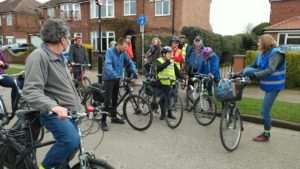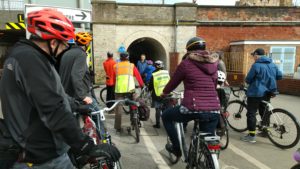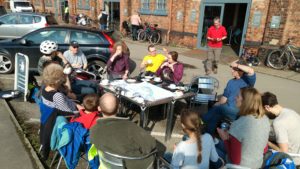
Saturday 14th April 2:00pm – 4:30pm.
The proposals for York Central – like almost every new development today – talk about “encouraging walking and cycling” and refer to “high quality cycle infrastructure”. But what does this actually mean – what makes a good cycle route and hence a good cycle ride? What can we learn from York’s existing infrastructure in order to make York Central a place where people want to cycle? We explored these questions through a guided ride led by York Cycle Campaign, exploring the roads and cycle paths of York. We looked at cycling infrastructure proposals for York Central and – with the experience of our ride fresh in our minds – discussed whether it will encourage us to cycle there.
The mix of bikes, and indeed riders, was broad. From a Brompton folding bike via various town and road bikes to heavyweights including an Elephant Bike and a few Gazelles, we also had one rider on a recumbent, and one rider aged ten. We were joined for the latter part (and discussion) by two younger children and a disabled rider on an adapted e-bike.
We kicked off the discussion by exploring which part of the route we enjoyed the most:
Most pleasant parts of the route
‘The New Walk cycling route feels like a useful route’
‘New Walk acts as a spoke into the city’
‘There is the factor that some routes become less attractive in certain weather or at different times, like at night’
‘How long after floods does it take to be cleared? It takes two or three days to clean it, depending on how likely it is for the rivers to come back up’
‘I enjoyed Hob Moor, it’s very useful for Holgate/ Acomb as a safe route’
‘It made a difference where there was a green filter reservation space where cyclists can go first’.
What did people find the most frustrating part of the ride?
‘Pot holes. They fill them in, but they fill them for a car and not for a cyclist – they end up as humps’.
—
‘I’d forgotten how bad Wilton Rise is – because it is unadopted’
‘Wilton Rise is part of the designated cycle route’. (It is unadopted but it was resurfaced by the council on a one off basis, following deterioration caused by utilities works).
—
‘I didn’t like crossing Leeman Road to get to the Scarborough Bridge – you need to get to the traffic island and you have to wait there and the traffic island was not very big at all’.
—
‘Getting across to Marble Arch from Cinder Path it’s not at all clear where to cross the road’.
—
Ouse Bridge: ‘Saturday afternoon is never a good time for cycling’.
‘The pavements get very busy and so people step out without looking’.
‘Ouse bridge – I feel quite squeezed out as a cyclist’.
‘It is very tight’.
‘That’s where all the drunk people are’.
—
‘Getting across main roads (Butcher Terrace, Leeman Road) was an issue. They were the points where we got broken up as a group’.
—
‘The gates and cattle grids on Hob Moor are appalling, we could make them more cycle friendly’.
‘Making a good cycle path should be about removing barriers and making is easier’.
‘Residents are able to get keys to open side gates – but this is not well advertised’. ‘Opening a gate would not be easy for people with disabilities’
‘There are genuine issues with cows and mopeds but there must be other ways of doing this – let’s explore how other places tackle this. Town Moor in Newcastle?’.
The York Central overall movement strategy:
‘All the routes are in the same place, the cycle route would be along the same route as the road route. There would be little separation.’
‘We need to have people being able to cycle in opposite directions, including with tricycles or trailers’.
‘I wouldn’t mind having a longer route, if it was separated. In Munster they have a perimeter route around the outskirts of the city centre, it is not the most direct route but there is certainty about how to use it and it takes some of the discomfort out’.
‘Half the problem with getting people to cycle is feeling safe – the safer people feel the more likely they are to cycle’.
“How will cyclists feed into Water End?’ ‘The access route will be worked up in detail for the outline planning application’.
‘There are not many access points into York Central. Routes across are crucial to make it feel connected’.
‘Access to the station is important, if you live in Holgate you don’t want to go all the way round to get the station’
In York Central, is it a leisure route or commuting? ‘There are different purposes to cycle routes. I wouldn’t choose New Walk if I wanted to get there quickly’.
Who will own the public space in York Central?

York Central plans – Marble Arch and Leeman Road Tunnel:
- Option 1: Do nothing
- Option 2: Marble Arch as pedestrian tunnel, half of road two way cycle route, other half light-controlled alternate traffic route
- Option 3: Marble Arch as pedestrian tunnel, cyclists and cars together on road through tunnel.
Can there be an Option 4 of ‘ban cars’ with a bus gate?
‘It is very important that people indicate Option 2’ ‘But Option 2 isn’t ideal’.
‘Surely you can’t do that because of car access to the NRM?’ ‘but you can get there the other way via the Water End access route’
‘What about putting the pedestrian route within the tunnel on the existing footway next to the cars?’ ‘It’s not wide enough. What about push chairs?’
York Central Plans – Proposed southern pedestrian / cycle route from Holgate
We discussed the various options for Wilton Rise. We looked at Option 3, which would be a more secluded route, would that be okay?
‘Cinder Lane, became better once they removed the walls – it felt safer. I don’t feel unsafe if I’m cycling – you don’t stop so that’s fine – but I would not cycle over Scarborough Bridge as it is currently. You’re more vulnerable there’.
‘If it is well designed and well lit – then it will be well used and safe’
‘If you feel safe then you use it’
‘Marble Arch was well lit and that made a difference’.
York Central Plans – access through NRM if Leeman Road is closed off
‘I think it should be permanently accessible route for pedestrians and cyclists’
‘Being shut at night will reduce accessibility. It would be like not having the Millennium Bridge open at night’
‘It would contradict the desire for connectivity’
We then shared the information about time taken on the proposed diverted routes, with the suggestion that it is only 2-3 minutes extra…
‘But if you are in a wheelchair or with a strict time limit then three minutes is significant’.
‘It is the psychological side, it is about people who live here feeling they are connected to the city centre’.
‘If it feels like private space that is closed at night then you will feel cut off’.
‘If people don’t use those routes at night then it becomes more dangerous’.
Overall – what makes a cycle route pleasant?
Is cycling by a park a positive thing or, after dark, a negative thing?
‘Lighting and space is important’
‘Bushes and trees during the day time might look good but at night, low foliage next to the park can make it feel unsafe’
‘Clear lines of sight make people feel safe and therefore they will use the spaces more’
‘You can use light to make a path feel safe at night, you don’t have to remove all vegetation’
‘You can use landmarks that gives it a sense of being a place’.
‘You need good way finding facilities as well’.
—
‘Some kind of route into the NRM, with some sort of historical trail. That was the reason for stopping at the Hob Stone on our ride. A good ride is one with a sense of place’.
How should we maintain cycle paths?
A member of the group is a volunteer on Sustrans paths – where they clean up glass as well as cut back vegetation. He asked ‘would a team of volunteers who might live on York Central, end up being responsible for doing that – or would the council?’
‘On the cycle path that goes through Derwenthorpe there was a lot of litter and the residents are taking it on themselves to do litter picking along that route. A good cycle path is one with litter bins on the route’.
‘It has got worse the last few months – part of that is budget cuts’.
‘Low shrubs are a bit too good for holding litter – and make it hard to get out’.
Another member of the group asked: ‘Why should it fall to volunteers, if that was a road it would be maintained?’
‘The Sustrans routes are different they are owned by Sustrans’.
‘Where the paths are council owned and adopted, if there is broken glass the council will remove it if reported’.
How / do we share space between pedestrians and cyclists?
We talked a lot – having experienced a couple of stretches of shared space on New Walk and Kings Staithes – about whether – and how – space can be shared between pedestrians and cyclists:
New Walk is better defined but after Blue Bridge ‘should be better defined’
‘It is a good idea to keep pedestrians and cyclists separate – Kingsway North is a good example’
‘I like routes that are clearly for cyclists or clearly for pedestrians. The one on Clifton Bridge is meant to be cyclist only but it’s not clear to pedestrians. I like them with a white line and where its two way for cyclists and then it feels dedicated’
‘We could change the colour for cycle paths’ ‘…but the colour comes off easily, as do the white markers’
Others felt that shared space can work:
On New Walk, ‘I think it is clear that it is shared space’
‘There were two children who were in danger of being injured as they were wandering around’
‘Cyclists need to slow down and cycle sensibly’. ‘In shared space cyclists need to slow down’
‘I was having trouble cycling through the crowds of walkers, then I joined the group and that was much easier‘
‘Cycling in this country became aggressive because they had to fight for space…’ ‘But it doesn’t help…’
…and possible ways of managing shared space better:
‘When we did the ‘Secret Life of York’s Public Spaces’ event we looked at shared space – especially the shared route past the Minister. What we thought worked well there was that there needed to be very generous shared space with enough room for cyclists to cycle around pedestrians’.
‘Shared space needs legibility – you need to know you are in shared space’
‘Shared space is great if you are out for a leisure cycle ride but if I am commuting then I want to go fast’.
This suggests a possible idea to develop further: that different type of use needs to be separated, not mode (walking or cycling). Direct cycling routes should perhaps be separated from pedestrians but where the focus is clearly more about leisure, then maybe separating out walking and cycling is less necessary – given enough space.

Final thoughts: Principles of what makes a good cycle route:
- Types of use: Cycle routes for people to get on for a hurry – straight and clear (direct commuting). Shared spaces where there is an understanding of more relaxed use (leisure)
- Priority: Cycle routes generally should have priority over side junctions – a straight, level route across junction mouths rather than having to follow the kerb around the corner. ‘You want to have priority and not be worried about checking for vehicles turning left’.
- Routes should be legible and have clear waymarking, and be continuous.
- Routes should not require cyclists to dismount at hazards.
- Where cyclists have to cross busy roads, signalised crossings should be provided.
- Cycle parking should be provided at likely route destinations.
- Cycle routes must be maintained properly (to a higher standard than the general highway since the impact on safety is greater) and must be cleared of snow / ice / mud / vegetation promptly when required.